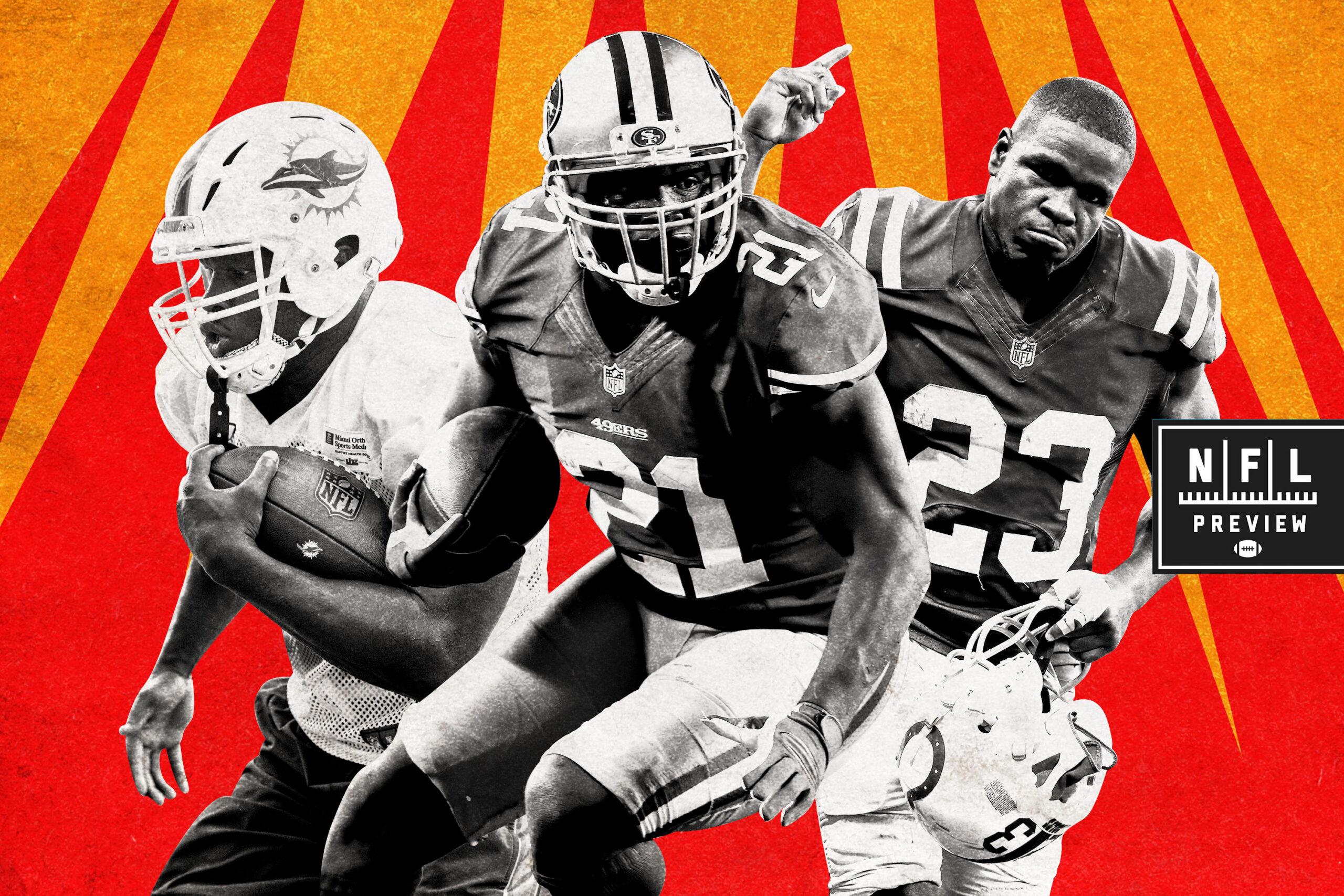
Running is the past. Passing is the future. With completion percentages across the NFL continuing to rise, your average handoff seemed destined for the dustbin of inefficient history, nestled in between the midrange jumper and the sacrifice bunt. Yet, while their contracts have suffered, running backs are still here. So, welcome to … Running Back Day! We’re spending all day trying to answer the question of “What does it mean to be a running back in 2018?”
In 2015, Chiefs running back Jamaal Charles said he wanted to play for six more years. That seemed like a lofty goal for a 28-year-old at a position in which few players last beyond 30, but Charles had a plan. As he explained to the Chiefs’ official website that May: “The game has changed. … They’ve got all kinds of technology now, all kinds of medicine people have come up with to stay healthy. At the end of the day, an ACL you couldn’t play [with], it was the end of a career.”
Charles tore his ACL that October, and after a couple other lackluster seasons, he’s not on an NFL roster this year, likely spelling the end of his NFL career. It turned out that, despite all those medical advances, the running back with the highest yards-per-carry average of all time could not outrun history.
But there is one active NFL running back who continues to defy Father Time. At 35, Miami’s Frank Gore is the oldest back in the league. Yet Gore still rushed for more than 900 yards last year with the Colts — the next oldest player in the league to cross that mark was Buffalo’s LeSean McCoy, who is a full five years younger than Gore.
And Gore isn’t just the best old-man running back right now — he’s one of the best ever. The 5,187 rushing yards he’s accumulated in his 30s ranks third all time for anyone in that range, behind Emmitt Smith and John Riggins, and he just put in the fourth-most-productive single season for a running back aged 34 or older last season. As other running backs in the NFL have dropped like flies once they hit age 30, Gore has continued chugging along.
In March, Gore signed with the Dolphins on a one-year deal after three years with the Colts and 10 with the 49ers. He says he’s not thinking about retirement yet, and that he’s in Miami to “still play.”
“I’m going to help the young guys, but I want to show my fans and family I can still be a top guy in this league,” he said.
But one-year deals spell trouble for aging players, and should this turn out to be Gore’s last season, he’ll be putting a bow on one of the longest careers for a running back in recent memory — as well as setting up one of the most interesting Hall of Fame cases in league history.
To begin to understand how Gore has lasted so long, you have to acknowledge his strongest trait as a runner: his vision. He’s not the most athletic running back, but that doesn’t mean he isn’t one of the most gifted. As Gore told NFL.com in November: “One thing God blessed me with: heart and these,” Gore said, pointing to his eyes. “On film, it looks like I ain’t doing nothing. Nothing special. But when they play me, it’s a different thing.”
In 2014, then–49ers coach Jim Harbaugh also heaped praise onto Gore’s ability to find the crease in the defense: “I think he is a mystical man,” Harbaugh said. “I think he sees things that we don’t — I don’t — we don’t see.”
That’s what gave Gore the ability to pull off runs like this one from Super Bowl XLVII:
Gore is able to see how plays will develop, when he needs to hit his holes, and what blocks to follow. It’s a trait that not only keeps him moving down the field, but keeps him upright. That vision transfers across sports, even to the boxing ring, where Gore spends his free time. In 2016 his boxing trainer explained to Bleacher Report how Gore’s vision keeps him from taking big hits.
“He doesn’t take many shots flush on,” Brian Schwartz, Gore’s trainer, said. “He’s hitting those little tiny holes, and if you’re getting him, you’ll wrap up, but you’ll rarely get a full lick on him.”
Gore has played at least 14 games in 12 of his 13 seasons — including all 16 in each of the past seven years — and the one year he dipped below that mark (2010) he played in 11 before fracturing his hip. That run of health is even more incredible considering Gore tore his ACL twice in college at Miami. Part of staying in the league for 13 seasons is just staying on the field, and Gore’s long-term health is nothing short of incredible — especially given his rough-and-tumble style of play.
In a snowy Week 14 Buffalo game last season, for example, Gore racked up 36 carries — the most ever for a running back at age 34 — for 130 yards. He broke his thumb in that game … and kept playing. The Colts suggested Gore get surgery to insert a pin in the thumb, which would end his season, but Gore declined and ended up playing in the team’s Thursday-night game just four days later.
Gore has also been in excellent shape throughout his career. When he signed with the Dolphins, it meant a reunion with head coach Adam Gase, who coached Gore as an offensive assistant with the 49ers. Even after a decade apart, Gase marveled at Gore, saying “the guy looks exactly the same” as he did 10 years ago.
Still, there’s no doubt that Gore has slowed some. Last season, he ranked 18th in Football Outsiders’ DYAR among running backs, and Pro Football Focus graded him as the league’s 23rd-best back. Those are still solid stats, but they’re hardly putting him into Pro Bowl consideration. At this point in his career, it’s more interesting to discuss Gore’s legacy than it is his future.
There is one question that hangs over any celebration of Gore: Will he make the Hall of Fame?
His case is unique. Gore has had a long and productive career, but he hasn’t had much of a peak. He has made just five Pro Bowls and has never been named a first-team All-Pro. He was close in 2006, being named to the AP’s second-team All-Pro squad, but it’s hard to argue he was snubbed. While his 2,180 yards from scrimmage that season ranked fourth overall, his advanced stats were more lukewarm. Gore ranked seventh in Football Outsiders’ DYAR among running backs that season, and Pro Football Focus showed that he gained a whopping 1,126 yards before contact — tops in the league — indicating that stellar offensive line play boosted his raw numbers.
Here’s a list of every Hall of Famer who played in the post-merger era who made five or fewer Pro Bowls and earned zero first-team All-Pro selections:
- Dick LeBeau, who was selected in 2010 as much for his coaching contributions as his on-field success
- Jackie Smith, who retired in 1978 and made it to the Hall in 1994
- Tony Dungy, who played only two years in the NFL and made it in 2016 because of his exemplary coaching career
That’s it. There are a number of other players who played before 1970 who made the Hall without Pro Bowl or All-Pro accolades, but they played in such a different version of the NFL that it’s difficult to draw any conclusions about what their HOF status could mean for Gore. So unless he is looking to continue his career as a head coach, the precedent for him is essentially Smith — but even that’s a stretch. Smith was one of the league’s first pass-catching tight ends. He retired with the record for receiving yards for tight ends, and he’s credited with helping transform that position into the role it occupies today. Gore has been a great running back, but he hasn’t done anything that will leave an impact on his position the way Smith did for tight end.
Gore’s case rests solely on his longevity. And in that department, he’s a superstar. Gore has racked up 1,200 yards from scrimmage in each of the past 12 seasons, which is the longest such streak in history by two years. And all three of the guys tied for second — Emmitt Smith, Barry Sanders, and Curtis Martin — are in the Hall of Fame. Gore is fifth all time in career rushing yards (he needs only 76 more to jump into fourth place) and every other player in the top 15 is either in the Hall or will be someday soon. By nearly every counting metric, Gore sits in the company of Hall of Famers.
But Gore also doesn’t have that magical trophy that could help boost his chances. Though he posted a solid 110 rushing yards on 19 carries in the 49ers’ Super Bowl against the Ravens, San Francisco lost that game, 34-31. He had a couple other runs to the NFC championship game, but that’s it for his postseason accolades. Maybe that will change with the Dolphins this season, but it isn’t likely.
In Miami, Gase has said he wants to use Gore as more than a mentor, calling the running back’s age “irrelevant.” But it’s no secret that second-year pro Kenyan Drake will be the lead back this season. Even Gore understands this, telling The Palm Beach Post earlier this month that he can “kinda see why [the Dolphins] traded Jay Ajayi.”
So even though Gore says he hasn’t thought about retirement, it’s likely coming soon. That means his Hall of Fame case and his career as a whole will soon face a lot more scrutiny. And if 2018 does turn out to be his swan song, he’ll go down as one of the only running backs in NFL history who could last into his mid-30s. He hasn’t just made history — he’s outrun it.


